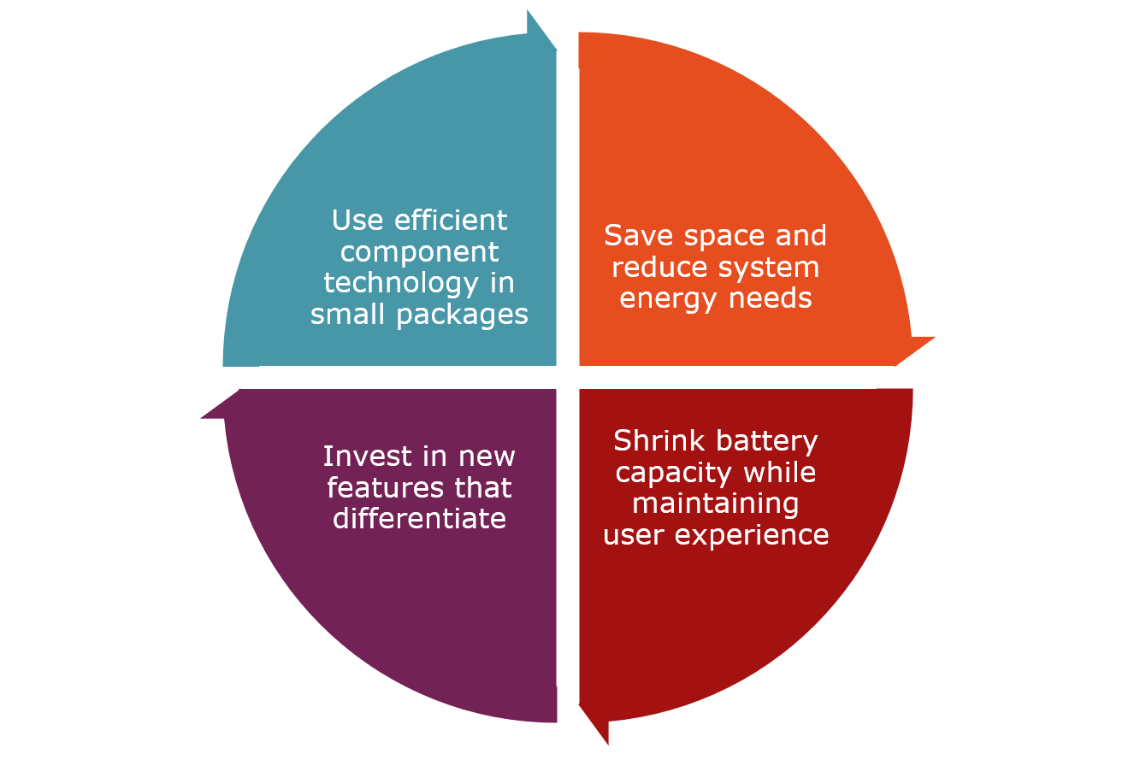Smartphone and peripheral manufacturers face conflicting consumer demands. Finding space for the next generation of features is proving a challenge. How to remedy smartphones’ weight gains?
New features and larger screens drive smartphone obesity
End-users increasingly want large-screen portable devices, yet also prefer to conveniently minimize recharging frequency. Typically these conflicting expectations have been met by increasing display panel size and battery capacity, resulting in smartphones becoming larger and weighing more. Today’s flagship smartphones are roughly 25% heavier than in 2012. Back then the leading flagship smartphones weighed 112g and 133g, while comparable 2018 devices from the same manufacturers weigh 148g and 163g respectively. Innovations such as bezel-less displays have obviously not fully compensated for this trend.
Now with the arrival of 5G, whose signal reception requires more complex antenna designs and additional RF modules, finding space to house differentiating features in tomorrow’s smartphones is becoming more critical. 5G combines sub-6 GHz frequency and omni-directional antennas with millimeter wave (mmWave) technology which necessitates several combined radiators. Together they will significantly increase the RF front-end and antenna footprint.

To continue building devices consumers can use conveniently and preserve the form-factor they’re used to, shrinking components will help optimize the real estate. Considering that flagships smartphones are equipped with up to 25 separate logic and ESD protection components, space savings delivered by modern small-footprint discretes can be significant. At Nexperia, we lead the industry by squeezing more functionality into ever smaller package footprints while constantly pushing efficiency and performance gains.
Our continuous innovation in silicon and package technology notably supports the key miniaturization trend with wafer-level chip scale packages (WLCSP) and extremely-thin small outline (XSON) packaging options. Nexperia’s leadless packages have long been a solution to save PCB space and add functionality to the design process, often offering different functionality in the same package footprint for flexibility in board layout.
Switching to mini portions for logic
In standard logic for example, our DQFN (Depopulated very-thin Quad Flat-pack No-leads) packages save up to 76% space compared to TSSOP (Thin-Shrink Small Outline Package) options, offering advantages in combatting unnecessary use of space. Further to this, our Mini Logic family includes X2SON, the smallest plastic logic packages in the industry for use without a step-down mask. With a proven track-record dating back to the launch of the 5-pin X2SON package in 2012, the X2SON leadless packages now also exist in 4, 6 and 8-pin variants and can save up to 63% space compared to their PicoGate equivalents.
Introduced in 2018, the new X2SON4 package option enables pin-count reductions for various single-gate functions. When comparing X2SON4 to the popular XSON6, a popular option back in 2012, up to 81% weight reduction can also be achieved. Despite such significant miniaturization and slimming, all X2SON packages can be used without a step-down stencil allowing for easy and cost-effective mass production.
All of the 100+ logic functions available in the X2SON package family are also based on our AUP, AXP, LV and LVC low-power technologies. Cutting power needs dramatically, AUP and AXP allow for standby current as low as 0.9 and 0.6 µA respectively.
Slim-fit ESD protection, filtering and signal conditioning
Footprint reduction is also possible with Nexperia’s ESD protection components, thanks to electrostatic discharge protection solutions in DSN0603-2 (SOD962-2). Our TrEOS portfolio offers extremely low peak voltage solutions and extremely high surge rating solutions to ensure optimized high-quality protection in a minimal footprint. TrEOS ESD protection cater to USB 3.x and other standards protect single high-speed data lines are available in this industry-standard small and lightweight package which only measures 0.6 x 0.6 x 0.3 mm, meeting the mobile market’s space constraints while delivering superior performance.
Nexperia also provides flexibility to designers, letting them choose between ESD-only protection and common mode filters with ESD protection at a later stage in their product creation process. This is possible as both functionalities are available in very compact and signal-friendly WLCSP packages. Through these miniaturization efforts, Nexperia has also efficiently combined ESD protection and EMI filtering in a single package.
Keeping the focus on feature innovations
By employing small leadless solutions from Nexperia’s standard products portfolio, mobile and portable manufacturers can develop smaller, thinner and lighter devices using modern and proven logic and ESD protection devices. In addition, when using smaller and more power-efficient standard products alongside next-generation SoCs, energy needs are reduced. This in turn allows battery capacity reductions, creating a virtuous circle of efficiency that reverses the mobile obesity trend – all without impacting the continuous enhancement of features.